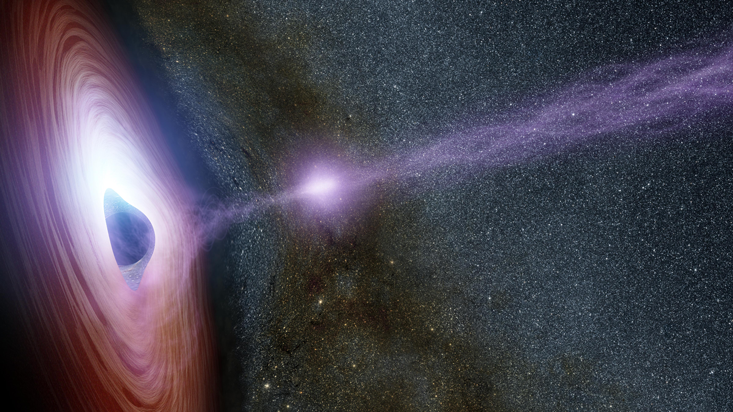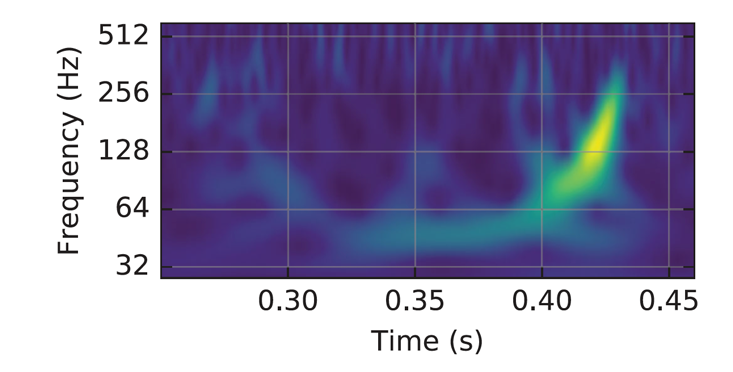We don’t believe in time travel, and we’re not into mysticism. But what if we could write a letter to Albert Einstein to tell him about gravity and black holes in a few paragraphs? We’d write something like this letter.
Steven Gubser and Frans Pretorius
Department of Physics, Princeton University
July 2017
Dear Albert,
First, you’re the greatest. The one equation in physics that everyone knows is E = mc2 . Time magazine named you the Person of the Century. Einstein jokes aren’t told much anymore because everyone sees the punch lines coming from a mile away. We’ve got a gazillion nuclear weapons, but we haven’t blown ourselves up yet. In fact, the atom bombs dropped at the end of World War II are the only ones ever used to intentionally kill people.
We’re really interested in general relativity and black holes these days because a big instrument called LIGO detected gravitational waves from a black hole collision that occurred over a billion years ago. We wrote a book about black holes, and since we know you were deeply interested in Schwarzschild’s solution, and maybe sometimes unsure of its physical significance, we thought we would tell you about what’s been happening in the sixty-plus years since you’ve passed on.
Everyone is impressed all over again with general relativity.
First, there’s this thing called the event horizon in Schwarzschild’s solution. If you go behind it, then you can’t come back out again without exceeding the speed of light. If you remember the form of Schwarzschild’s solution, there were some strange features when radius was equal to mass up to a factor of Newton’s coupling. In particular, the time-time part of the metric vanishes—what we now call the lapse function. That’s where the event horizon is. Schwarzschild’s solution also has strange features when the radius goes to zero, and our best understanding is that these strange features mark a spacetime singularity where geometry itself breaks down. If you enter into a Schwarzschild black hole, you’re bound to encounter the singularity, but we have no idea what would happen next—or even if “next” is a good word to use.

We wish you could have seen all the work done on general relativity in the 20 or so years after your passing. John Wheeler was at the center of it all. (And we knew him! He lived until 2008 and spent time with us both at Princeton.) He popularized the term “black hole” to describe Schwarzschild’s solution and related metrics. A New Zealander by the name of Roy Kerr found a generalization of the Schwarzschild metric which describes a rotating black hole. It’s quite a complicated metric! And it’s important because it describes the end state of collapsing stars, which always have some nonzero angular momentum.
We’re pretty sure now that there are lots of black holes in the universe. Like Chandrasekhar, Tolman, Oppenheimer, and Volkoff were saying in the thirties, if you put too much mass together, nothing can hold it up. It’s hard to figure out the exact numbers, but if about three solar masses remain after a star uses up all its nuclear fuel, it’s going to collapse into a black hole. What’s far more amazing is that there are much bigger black holes at the middle of galaxies. The Milky Way harbors a black hole at its center which contains about 4 million solar masses. We’re not pulling your leg! Modern consensus is that a lot of galaxies have much bigger black holes at their centers, maybe containing billions of solar masses. We’re not sure how these black holes formed, but in the case of the Milky Way we can be sure of its existence by tracing the orbits of individual stars and seeing the effects of the black hole’s gravity.
The LIGO detection of gravitational waves was just terrific. LIGO is a big Michelson interferometer, measuring 4 kilometers on a side. LIGO stands for Laser Interferometer Gravitational-Wave Observatory. Lasers are these amazing monochromatic light sources, so focused and powerful that we can use them to weld metal, but so cheap that we build them into modern record players in place of needles. We haven’t got flying cars yet, but lasers are pretty nifty. Anyway—LIGO was just setting up for a serious science run, when along came this perfect gravitational wave form which they picked up almost by accident and were able to match to a template that describes the merger of two black holes, each on the order of 30 solar masses.
It’s almost as if quantum theory is a projection of general relativity!
Everyone is impressed all over again with general relativity, because it’s successful in describing the strong field region near the black holes where spacetime is practically getting torn to shreds, and also the far-field region where gravitational waves are the faintest whispers gliding through spacetime.

Another of your ideas that has come a long way is the cosmological constant. Even though you called it your biggest blunder, we now think that it’s present as a small correction to your field equations. It’s actually important at large length scales: Astronomers can’t explain the recent evolution of the expanding universe unless a whopping 70 percent of all energy in the universe comes from the cosmological constant, or at least something we call “dark energy” that behaves very much like it. Rather than keeping the universe static as you had hoped when you first introduced the cosmological constant (brace yourself), dark energy is starting to accelerate the universe onto a track of exponential expansion. Going in another direction, the quest for a unified theory has led to intense study of spacetimes with a negative cosmological constant. General relativity in five dimensions with a negative cosmological constant connects naturally with a quantum theory on the four-dimensional boundary of spacetime. It’s almost as if quantum theory is a projection of general relativity!
We’re really sure now that quantum theory is right. (Sorry about that.) A British physicist named Stephen Hawking showed that quantum theory implies that black holes emit radiation, albeit at very low temperatures. Black holes also have a tremendously large entropy, despite being almost unique as solutions to your field equations. If it makes you feel any better, the paper you wrote with Podolsky and Rosen turned out to be important. People are even trying to build quantum mechanical computers nowadays using ideas related to that paper.
A lot of Princeton professors don’t wear ties to work anymore, but most of us do wear socks. Lake Carnegie is as beautiful as ever. We don’t see many sailors out there, but there’s been an eagle nesting right on the edge of the lake. We haven’t figured out a unified field theory yet, but we’re still trying. The best is yet to come.
Yours truly, Steve and Frans
Steven S. Gubser is professor of physics at Princeton University and the author of The Little Book of String Theory.
Frans Pretorius is professor of physics at Princeton University.
Excerpted from The Little Book of Black Holes by Steven S. Gubser and Frans Pretorius. Copyright © 2017 by Steven S. Gubser and Frans Pretorius. Published by Princeton University Press and reprinted by permission.
Lead image credit: Khakimullin Aleksandr / Shutterstock






























